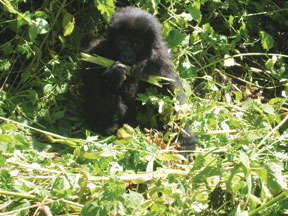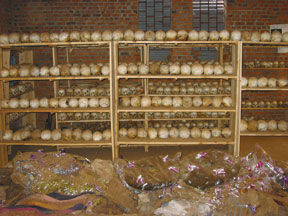December
2005/January 2006
Amahoro
in the Kingdom of Gorillas
By Sangamithra Iyer
|
 |
Baby Gorilla from Amahoro
Group.
Photo by Sangamithra Iyer |
 |
Ntarama Church Genocide Memorial.
Photo
by Sangamithra Iyer |
Last summer, before our rigorous hike to see
the primates of Rwanda’s Nyungwe Forest, my traveling companion,
Rachel Cernansky, had asked our guide, Clauvelle, whether the journey
would be difficult. His response was, “Yes, but we are lucky—we
are strong.”
Though known as the land of a thousand hills and home of the famous gorillas
in the mist, Rwanda is most remembered for its brutal and expedient genocide.
My interest in Rwanda first peaked several years ago, when I read Philip Gourevtich’s
We Wish to Inform You that Tomorrow we will be Killed with our Families during
my daily commute on Metro-North. Each day on the train, I would travel back in
time to Rwanda, trying to put the pieces together of this nation’s well
orchestrated and efficient genocide—about one million killed in the course
of 100 days. My questions then were how and why did this happen and how and why
did the world let it happen? I was obsessed with trying to understand violence
and the climate of fear and trauma that surrounds it, as well as searching for
a meaningful answer—beyond dancing around rhetoric—on how to respond
to and prevent such atrocities in the future.
My journey to Rwanda last summer was prompted by a different set of questions.
What is it like now, over a decade since the massacres of 1994? How do people
rebuild their lives? How does a nation heal?
Two things that first struck us were how serene and safe Rwanda was and how united
the people seemed. It would be easy to forget that this beautiful tranquil place
hosted such horrific events, but we were constantly reminded that it did. No
one was unaffected and everyone we talked to was somehow connected to the violence
and loss the nation experienced. Genocide had become a household word.
Some of the biggest reminders of the massacre are the memorials and the mass
graves that have sprung up all over the country. They vary in type and scale.
At the National University in Butare, there is a tent on campus dedicated to
the students and almost the entire faculty who were murdered in 1994—“the
loss that shall never be replaced.” Other memorials, like the church in
Kibuye where 11,000 people were killed, have been rebuilt and serve as functional
places for communities to congregate. The most shocking and powerful of these
memorials were ones like the churches in Ntarama and Nyamata that have been left
as they were in 1994 scattered with the remains of those lost.
People fled to these churches for safety, but were provided with no such haven.
At Ntarama, we met Pacifique, who during the slaughter was hit in the head with
a machete and left for dead. He survived, but lost his whole family in this church
where we walked among the remains of the 5,000 others who were slain. Personal
items were scattered about: Rosaries. Little girl shoes. Children’s notebooks.
Scarves. Body parts were sorted and stacked. Piles of femurs in one area and
skulls lined up in shelves. Smashed skulls. Little baby skulls slashed in half
by a machete. Little baby skulls slashed into multiple pieces by a machete. Who
does this to a child? Who does this repeatedly to a child?
We wept profusely. The Kinyarwandan chorus in Wyclef Jean’s “Million
Voices” ran through my mind. “These are the cries of the children.” The
Gayatri mantra, a Hindu prayer, also repeated in my head, as my instinct was
to pray for these people, but my prayers like theirs would be inadequate.
Though I was well read on Rwanda, it wasn’t until going there that this
unimaginable dark past became very real to me. But over the course of a few weeks,
what was more striking was an unimaginable bright future also became a foreseeable
reality.
Signs of Hope
The challenges of the nation are many and include conflict management, trauma
care, rebuilding and establishing infrastructure, addressing environmental issues
of deforestation, erosion and high population density, caring for the many orphans
and street children, attending to and preventing the spread of HIV/AIDS, and
dealing with the large incarcerated population. But everywhere we traveled in
Rwanda, there was a bit of optimism and hope. In Gisenyi, we befriended Phiston,
a 16 year-old boy. When he told us about the genocide, he said with conviction, “In
Rwanda, it can never happen again.”
We met Rwandans committed to working on programs for street children and orphans.
We visited two coffee farm cooperatives and were excited that farmers were organizing
for a fair price for one of the country’s biggest cash crops. We even found
a women’s cooperative in Gikongoro that made soymilk and soy cheese!
The country recently reintroduced the traditional village court system of gacaca
to expedite the justice process for over 100,000 detainees who have been incarcerated
since the genocide. And while addressing the massive sewage problem generated
by prisons and the need for alternative fuel sources, the Kigali Institute for
Science and Technology designed biogas systems to reclaim methane from human
waste to partially fuel prisons. These solutions are being implemented in hospitals
and schools around the country as well. The government also placed a ban on plastic
bags, recognizing their vast environmental harm.
On the morning of our trek to see the gorillas in the mist, we woke up surrounded
by Sabinyo, Karisimbe and Bisoke, volcanoes whose names I knew from books, but
in real life resembled the mountain gorillas who call them home. We were off
to see the mountain gorillas in the gorilla mountains. The most recent census
indicated that the gorilla population in Rwanda is about 380, a small but increasing
number with 25 new babies identified. We visited a newly habituated group called
Amahoro, which means peace in Kinyarwandan. We spent the morning with the large
gentle leader, a silverback named Ubumwe, meaning unity, and met a recent young
addition to the group, a female gorilla named Rwanda.
As both gorillas and Rwandans struggle to survive, we thought how appropriate
and hopeful it is that Rwanda is in Peace led by Unity.
We are all Rwandan
The ethic groups Hutu and Tutsi often come up when reading or talking about Rwanda.
But in our travels, we never heard those two words. In attempts to quell ethnic
tensions, Rwanda eliminated ethnic identity cards. When sharing stories of genocide,
phrases like “the rebels” or “the killers” and “those
who were hunted” were used rather than primary ethnic labels. And when
people talked about themselves, depending on whether they spoke primarily English
or French, they would say, “We are all Rwandan” or “Rwandese.”
While the world points to the Rwandan genocide as a lesson on what went wrong,
I am most impressed with what has gone right since then. The ability for people
to live together is extraordinary. There is a constant duality of things that
Rwandans are reconciling. Facing the past, but moving forward. Healing but never
forgetting. Not to pardon, but to tolerate. While this genocide signified some
of the worst in humanity, the movement toward peaceful coexistence over the past
decade signifies some of the best.
The challenges are difficult and require extraordinary strength. I am reminded
of Clauvelle’s response. The journey is difficult, but they are lucky—they
are strong.